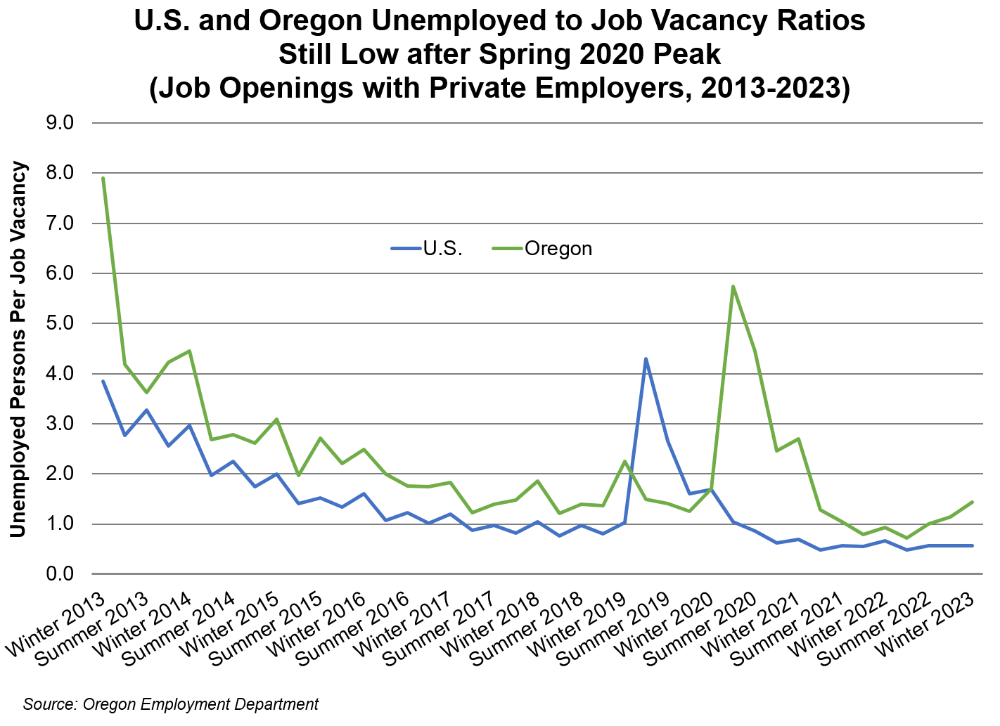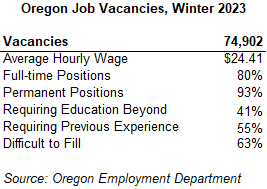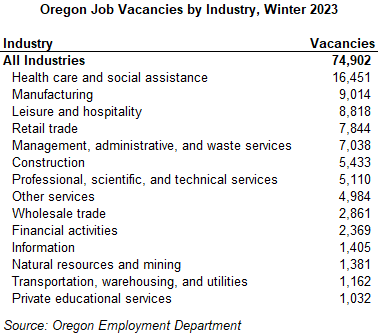Winter 2023 Hiring Among Oregon’s Private Employers
April 13, 2023Each quarter, the Oregon Employment Department surveys private employers from all industries and areas of the state to ask about the job vacancies they are actively trying to fill. Oregon businesses reported 74,900 job vacancies in winter 2023. Total job openings decreased 13% from fall 2022 and decreased 25% from winter 2022. This is the third quarterly decline in Oregon job vacancies, after a streak of four quarters above 100,000 vacancies. Pre-pandemic, the record high was 66,600 vacancies in summer 2017.
The current high level of job vacancies is not unique to Oregon. The number of private-sector job openings in the U.S. declined to 9.6 million in January 2023 after peaking at 11.4 million in April 2022. This peak significantly exceeded the previous high of 7.0 million seen in April 2019.
The unemployed-to-vacancy ratio remained low in winter 2023, although it is rising in Oregon, whereas the U.S. ratio has been steady. In January 2023, there were 9.6 million private-sector job openings in the United States, as measured by the Job Openings and Labor Turnover Survey, and 6.4 million people were unemployed, resulting in a U.S. ratio of 0.7 unemployed people per job opening (or seven unemployed persons per 10 job openings). This is the eighth straight quarter at or below a ratio of 1.0.
In Oregon, there were 108,100 unemployed Oregonians in January 2023 and the number of job vacancies fell to 74,900, leaving 1.4 unemployed people for every job opening (or 14 unemployed people for every 10 openings).

Most openings in the winter were for full-time, permanent positions. Education beyond high school was required for 41% of winter vacancies. A majority of employers reported their vacancies as difficult to fill, accounting for 63% of vacancies in winter 2023, down from 71% a year ago.
The average starting wage reported in winter was $24.41, about the same as in the fall (+0.2%) and a very strong 14.6% inflation-adjusted increase from winter 2022. Total vacancies were down 25% from the level in winter 2022. The number of vacancies offering a starting wage below $20 per hour decreased 47% over the year. The number of vacancies offering between $20 and $30 per hour decreased 10%, and vacancies paying above $30 per hour increased 70%.

Hiring demand was widespread throughout industries and occupations. Seven out of 14 major sectors were hiring for more than 5,000 positions at any given time in winter 2023. In contrast, prior to the pandemic in fall 2019, four out of 14 sectors saw this level of hiring. Health care and social assistance topped the industry list this winter, with 16,500 vacancies. Manufacturing accounted for 9,000 vacancies. The leisure and hospitality industry had 8,800 job vacancies.

Employers reported vacancies in 229 different occupations. The occupation groups with the most vacancies in winter 2023 were food preparation and serving related (8,100), sales and related (7,600), and health care practitioner and technical (6,400). Detailed occupations reported most frequently included retail salespersons, registered nurses, truck drivers, restaurant cooks, personal care aides, and nursing assistants.
Winter vacancies were distributed across the state, with the Portland tri-county area accounting for about 38%, which is a typical share for the state’s largest metro area. Vacancies decreased over the year in every region of the state, with the largest declines in the Rogue Valley and Eastern Oregon.

More details about Oregon Job Vacancies are available on QualityInfo.org, on the publications page under Job Vacancy Survey.